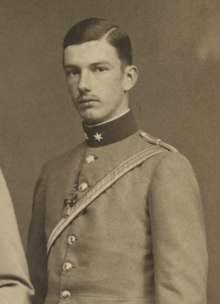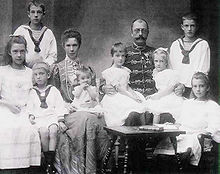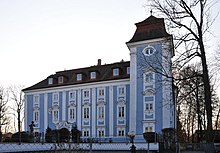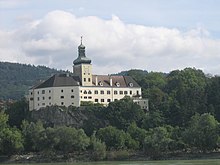Hubert Salvator Habsburg-Lothringen
Hubert Salvator Habsburg-Lothringen , born as Hubert Salvator Rainer Maria Joseph Ignatius, Archduke of Austria, Prince of Tuscany (born April 30, 1894 at Lichtenegg Castle in Wels , Upper Austria ; † March 24, 1971 at Persenbeug Castle , Lower Austria ) was an Austrian Officer of the Austro-Hungarian Army .
Life
family
Hubert Salvator was the second son of Franz Salvator of Austria-Tuscany and his wife Marie Valerie of Austria , daughter of Emperor Franz Joseph I. In 1926 he married Rosemary zu Salm-Salm at Burg Anholt in Westphalia , with whom he had 13 children.
First World War
During the First World War he served as a first lieutenant and Rittmeister in Dragoon Regiment No. 4 . He took part in trench warfare at Bug and Dubno . Then he was riding orderly officer with the 9th Mountain Brigade Command in the Dolomites . In 1914 Hubert Salvator received the Order of the Golden Fleece .
From September to November 1917, he was commissioned by Emperor Charles I , together with the orientalist Alois Musil , the Austrian Orient mission to Asia Minor , Syria and Palestine . The mission should protect the interests of the monarchy, especially in competition with the ally Germany , in the Ottoman Empire . Habsburg held the "representative management" of the mission, the head of the mission was the specialist Musil. The mission, officially sent to inspect troops and maintain contact with Ottoman officials and oriental Christians, also served the “dream” of Emperor Charles of a “religious protectorate of the Habsburgs in the Orient”. Karl wanted to take over the religious protectorate of France over the oriental Christians. The mission had economic, scientific-cultural and propaganda motives, while the military aspect was only a cover.
The experienced Austrian ambassador to Constantinople János von Pallavicini , who had tried in vain to prevent the mission because he feared conflicts with the Ottoman government, subsequently ruled that the Archduke had correctly grasped the situation in Palestine and Syria. Field Marshal Lieutenant Joseph Pomiankowski , kuk military plenipotentiary in the Ottoman Empire, remarked that Hubert Salvator made the best impression due to his very sympathetic appearance, his modest, amiable demeanor and his calm seriousness .
After the end of Austria-Hungary
After the end of the Habsburg monarchy , Hubert Salvator issued a waiver under the Habsburg law in 1919 and was therefore allowed to stay in Austria. In 1920 he received his doctorate from the University of Innsbruck for Dr. jur. Apparently excluded from the Order of the Golden Fleece because of the waiver, he and his father were reinstated in November 1922.
Hubert Salvator successfully managed a large forest enterprise in Persenbeug . Because of its extensive holdings, it was nicknamed "Schleusen-Hubsi". In 1924 he inherited the imperial villa in Bad Ischl from his mother . In the First Republic and in the time of Austrofascism , Habsburg was a high functionary of the Home Guard as a Gauführer . He was politically persecuted during the Nazi era .
During the Russian occupation after World War II , Habsburg was the chairman of the Persenbeug community committee . He lived and eventually died at Persenbeug Castle, which he owned together with eight other members of the Habsburg family.
progeny
Hubert Salvator and his wife Rosemary zu Salm-Salm had 13 children:
- Friedrich Salvator Habsburg-Lothringen (1927–1999)
- Agnes Christina Habsburg-Lothringen (1928–2007)
- Maria Margaretha Habsburg-Lothringen (1930)
- Maria Ludovica Habsburg-Lothringen (1931–1999)
- Maria Adelheid Habsburg-Lothringen (1933)
- Elisabeth Mathilde Habsburg-Lothringen (1935–1998)
- Andreas Salvator Habsburg-Lothringen (1936)
- Josepha Hedwig Habsburg-Lothringen (1937)
- Valerie Isabella Habsburg-Lothringen (1941)
- Maria Alberta Habsburg-Lothringen (1944)
- Markus Emanuel Habsburg-Lothringen (1946), today's owner of the imperial villa in Bad Ischl
- Johann Maximilian Salvator Habsburg-Lothringen (1947)
- Michael Salvator Habsburg-Lothringen (1949)
Web links
Individual evidence
- ↑ a b c d e Brigitte Hamann (Ed.): The Habsburgs. A biographical lexicon. Piper, Munich 1988, ISBN 3-4920-3163-3 , p. 156.
- ^ A b c d Robert-Tarek Fischer : Austria in the Middle East. The great power politics of the Habsburg Monarchy in the Arab Orient 1633–1918. Böhlau, Vienna 2006, ISBN 3-20577-459-0 , pp. 274ff.
- ^ A b c Wolfdieter Bihl : The Caucasus Policy of the Central Powers. Part 1: Your basis in the politics of the Orient and your actions 1914-1917 . Böhlau, Vienna / Cologne / Graz 1975, pp. 136 and 140.
- ^ Helmut Wohnout: The Austrian Hospice in Jerusalem. History of the pilgrim house on the Via Dolorosa. Böhlau, Vienna 2000, ISBN 3-20599-095-1 , p. 116f.
- ↑ Leopold Auer (Ed.): The House of Austria and the Order of the Golden Fleece. Contributions to the scientific symposium on November 30th and December 1st, 2006 in Heiligenkreuz Abbey. Leopold Stocker, Graz 2007, ISBN 978-3-7020-1172-7 , p. 71.
- ↑ Profil , No. 23, 1992, p. 135.
- ↑ Maren Seliger: Sham parliamentarism in the Führer state. "Community representation" in Austrofascism and National Socialism. Functions and political profiles Vienna councilors and councilors 1934–1945 in comparison. Lit, Vienna / Münster 2010, ISBN 978-3-643-50233-9 , p. 711.
- ^ Karl Vocelka , Lynne Heller: The private world of the Habsburgs. Life and everyday life of a family. Styria, Graz / Vienna 1998, ISBN 3-222-12642-9 , p. 332.
- ↑ Harry Slapnicka : The fate of the Ischl Imperial Villa after the death of Emperor Franz Joseph. A remarkable monument to Austrian history. (PDF; 481 kB) p. 187f.
- ↑ Ernst Trost : The Danube. Curriculum vitae of a stream. Molden, Vienna 1968, p. 183.
| personal data | |
|---|---|
| SURNAME | Habsburg-Lothringen, Hubert Salvator |
| ALTERNATIVE NAMES | Hubert Salvator Rainer Maria Joseph Ignatius, Archduke of Austria, Prince of Tuscany (birth name) |
| BRIEF DESCRIPTION | Austrian Archduke (until 1919) and officer |
| DATE OF BIRTH | April 30, 1894 |
| PLACE OF BIRTH | Lichtenegg Castle , Wels (city) |
| DATE OF DEATH | March 24, 1971 |
| Place of death | Persenbeug Castle , Lower Austria |




